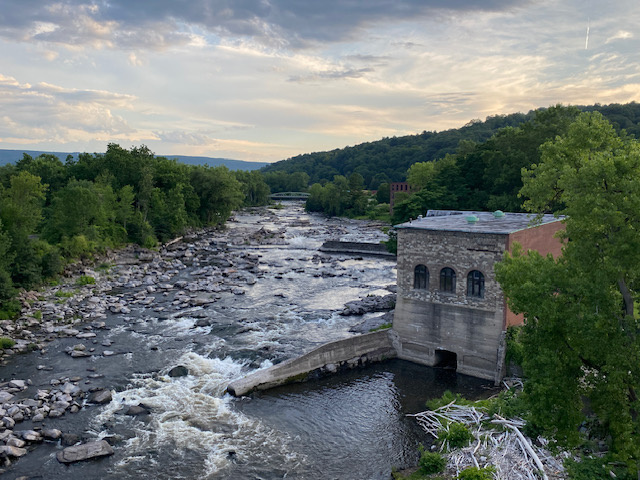
WomanTours’ NY Empire State Trail: Erie Canalway is a bike tour we run almost every year. The canal, after all, is right in our back yard, less than a quarter-mile from our Rochester, NY headquarters. Even though several members of our Rochester team use the canal regularly for bicycle commuting and recreation, we don’t take it for granted—it’s that special.
This year’s tour, which runs June 13-22, 2025, is particularly special as the Erie Canalway celebrates its 200th anniversary.
The country's first "Super Highway"
Connecting Lake Erie to the Hudson River, and in a bigger sense, the port of New York City with the markets of the Midwest and Great Lakes, the Erie Canal was the country’s first super highway. While the idea for such a canal took shape in the 1780s, the engineering challenges and costs led naysayers to ridicule it as “Clinton’s Ditch,” as then New York Gov. DeWitt Clinton championed the enormous infrastructure project. With a $7 million budget, work began in 1817 in Rome, and was completed in 1825. At the time, the 363-mile canal between Buffalo and Albany was second only to China’s Grand Canal as the longest in the world.
The benefits were both immediate and far-reaching. Before the canal, stagecoach travel between its endpoints took at least two weeks; by canal, the trip was only five days. Carrying commercial goods via the canal slashed cargo transportation costs by 90%. The state recouped its investment via toll revenues in less than a decade. Upstate New York thrived as canalside communities blossomed into thriving cities, including Syracuse, Utica, Rome, Rochester and Buffalo. Today, 75% of the Central and Western New York’s population lives within 25 miles of the canal.
The Erie Canal not only moved commerce and people, but it also spread new social ideas such as temperance, abolition of slavery and women’s suffrage. New religions such as the Latter Day Saints and Seventh Day Adventists also gained traction because of the canal.
Even as the railroad made its debut in the late 1830s, the Erie Canal competed successfully in commercial shipping until the early 20th century. The state then focused on building the New York State Barge Canal, which replaced a fair amount of the Erie Canal and allowed for much larger barges. But as highways and railroads took over and the St. Lawrence Seaway opened in the late 1950s, the Erie Canal finally had to forfeit its super highway supremacy.
Biking mecca of the 21st century
In the 21st century, the Erie Canal still handles some commercial shipping, though these days the primary boat traffic is recreational. Hiking and biking along the Erie Canal towpath is also alive and well. In 2000, Congress established the Erie Canalway National Heritage Corridor, which extends 524 miles from Buffalo, bends north in Albany and concludes the Champlain Canal in Whitehall.
Scenic and historic highlights on this bike tour
While biking along the scenic towpath may be the initial draw for our Erie Canalway tour, the historical and cultural stops along the way prove to be just as captivating. Here is what’s in store:
- After arriving in Lockport, you’ll cruise the canal and its locks and learn about “life in the past lane.” You can also visit the nearby Erie Canal Discovery Center.
- In the Rochester suburb of Pittsford, you’ll stay at a hotel that is right on the canal.
- In Seneca Falls, you can visit the Women’s Rights National Historic Park, where the first Women’s Rights Convention took place in 1848.
- In Syracuse, you’ll have the option to visit the Erie Canal Museum, housed in an 1850 weigh lock building that was used to collect cargo tolls.
- In Little Falls, you can explore Moss Island, an artificial island created during the canal’s construction.
- In Albany, you meet up with the mighty Hudson River.
- And throughout the tour, you’ll see locks, moveable dams, lift bridges and other infrastructure that made the canal work seamlessly for decades.
We’d love to have you along for the ride on this momentous bicentennial. And if you want to continue on the Empire State Trail to New York City, consider signing up for our Hudson Valley Greenway June 23-30, 2025 which starts right after the Erie Canalway tour ends.
Learn more about the Erie Canal
If you want to learn more about the Erie Canal’s history, check out these resources:
- Video: Floating Ideas: How the Erie Canal Shaped America.
- Digital exhibit: Hidden Perspectives: Women’s Lives on the Erie.
- Videos: Canal Locks and Structures.
- Book: Wedding of the Waters: The Erie Canal and the Making of a Great Nation by Peter L. Bernstein.
- Documentary series: Reflections on the Erie Canal, a 10-part series, will stream on demand beginning April 12, 2025.






